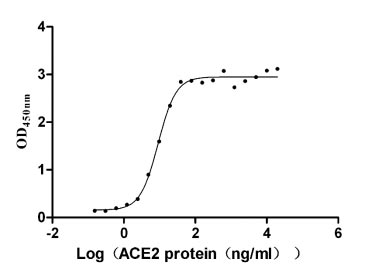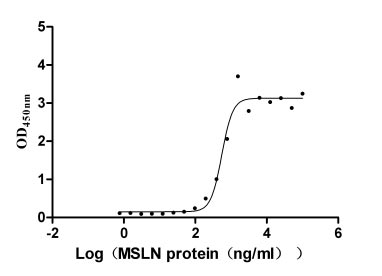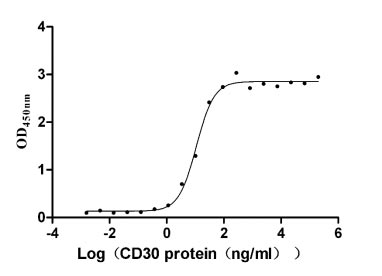Recombinant Avian infectious bursal disease virus Structural polyprotein
-
中文名称:Recombinant Avian infectious bursal disease virus Structural polyprotein,Yeast
-
货号:CSB-YP357367ASF
-
规格:
-
来源:Yeast
-
其他:
-
中文名称:Recombinant Avian infectious bursal disease virus Structural polyprotein,Yeast
-
货号:CSB-EP357367ASF
-
规格:
-
来源:E.coli
-
其他:
-
中文名称:Recombinant Avian infectious bursal disease virus Structural polyprotein,Yeast
-
货号:CSB-EP357367ASF-B
-
规格:
-
来源:E.coli
-
共轭:Avi-tag Biotinylated
E. coli biotin ligase (BirA) is highly specific in covalently attaching biotin to the 15 amino acid AviTag peptide. This recombinant protein was biotinylated in vivo by AviTag-BirA technology, which method is BriA catalyzes amide linkage between the biotin and the specific lysine of the AviTag.
-
其他:
-
中文名称:Recombinant Avian infectious bursal disease virus Structural polyprotein,Yeast
-
货号:CSB-BP357367ASF
-
规格:
-
来源:Baculovirus
-
其他:
-
中文名称:Recombinant Avian infectious bursal disease virus Structural polyprotein,Yeast
-
货号:CSB-MP357367ASF
-
规格:
-
来源:Mammalian cell
-
其他:
产品详情
-
纯度:>85% (SDS-PAGE)
-
基因名:N/A
-
Uniprot No.:
-
别名:Structural polyprotein; PP) [Cleaved into: Precursor of VP2; Pre-VP2); Capsid protein VP2; Structural peptide 1; p1; pep46); Structural peptide 2; p2; pep7a); Structural peptide 3; p3; pep7b); Structural peptide 4; p4; pep11); Protease VP4; EC 3.4.21.-; Non-structural protein VP4; NS); Capsid protein VP3]
-
种属:Avian infectious bursal disease virus (strain Australian 002-73) (IBDV) (Gumboro disease virus)
-
蛋白长度:Partial
-
蛋白标签:Tag type will be determined during the manufacturing process.
The tag type will be determined during production process. If you have specified tag type, please tell us and we will develop the specified tag preferentially. -
产品提供形式:Lyophilized powder
Note: We will preferentially ship the format that we have in stock, however, if you have any special requirement for the format, please remark your requirement when placing the order, we will prepare according to your demand. -
复溶:We recommend that this vial be briefly centrifuged prior to opening to bring the contents to the bottom. Please reconstitute protein in deionized sterile water to a concentration of 0.1-1.0 mg/mL.We recommend to add 5-50% of glycerol (final concentration) and aliquot for long-term storage at -20℃/-80℃. Our default final concentration of glycerol is 50%. Customers could use it as reference.
-
储存条件:Store at -20°C/-80°C upon receipt, aliquoting is necessary for mutiple use. Avoid repeated freeze-thaw cycles.
-
保质期:The shelf life is related to many factors, storage state, buffer ingredients, storage temperature and the stability of the protein itself.
Generally, the shelf life of liquid form is 6 months at -20°C/-80°C. The shelf life of lyophilized form is 12 months at -20°C/-80°C. -
货期:Delivery time may differ from different purchasing way or location, please kindly consult your local distributors for specific delivery time.Note: All of our proteins are default shipped with normal blue ice packs, if you request to ship with dry ice, please communicate with us in advance and extra fees will be charged.
-
注意事项:Repeated freezing and thawing is not recommended. Store working aliquots at 4°C for up to one week.
-
Datasheet :Please contact us to get it.
靶点详情
-
功能:Capsid protein VP2 self assembles to form an icosahedral capsid with a T=13 symmetry, about 70 nm in diameter, and consisting of 260 VP2 trimers. The capsid encapsulates the genomic dsRNA. VP2 is also involved in attachment and entry into the host cell by interacting with host ITGA4/ITGB1.; The precursor of VP2 plays an important role in capsid assembly. First, pre-VP2 and VP2 oligomers assemble to form a procapsid. Then, the pre-VP2 intermediates may be processed into VP2 proteins by proteolytic cleavage mediated by VP4 to obtain the mature virion. The final capsid is composed of pentamers and hexamers but VP2 has a natural tendency to assemble into all-pentameric structures. Therefore pre-VP2 may be required to allow formation of the hexameric structures.; Protease VP4 is a serine protease that cleaves the polyprotein into its final products. Pre-VP2 is first partially cleaved, and may be completely processed by VP4 upon capsid maturation.; Capsid protein VP3 plays a key role in virion assembly by providing a scaffold for the capsid made of VP2. May self-assemble to form a T=4-like icosahedral inner-capsid composed of at least 180 trimers. Plays a role in genomic RNA packaging by recruiting VP1 into the capsid and interacting with the dsRNA genome segments to form a ribonucleoprotein complex. Additionally, the interaction of the VP3 C-terminal tail with VP1 removes the inherent structural blockade of the polymerase active site. Thus, VP3 can also function as a transcriptional activator.; Structural peptide 1 is a small peptide derived from pre-VP2 C-terminus. It destabilizes and perforates cell membranes, suggesting a role during entry.; Structural peptide 2 is a small peptide derived from pVP2 C-terminus. It is not essential for the virus viability, but viral growth is affected when missing.; Structural peptide 3 is a small peptide derived from pVP2 C-terminus. It is not essential for the virus viability, but viral growth is affected when missing.; Structural peptide 4 is a small peptide derived from pVP2 C-terminus. It is essential for the virus viability.
-
亚细胞定位:[Capsid protein VP2]: Virion. Host cytoplasm.; [Capsid protein VP3]: Virion. Host cytoplasm.; [Structural peptide 1]: Virion. Host cytoplasm.; [Structural peptide 2]: Virion. Host cytoplasm.; [Structural peptide 3]: Virion. Host cytoplasm.; [Structural peptide 4]: Virion. Host cytoplasm.
Most popular with customers
-
Recombinant Human SARS coronavirus Spike glycoprotein (S), partial (Active)
Express system: Mammalian cell
Species: Human SARS coronavirus (SARS-CoV) (Severe acute respiratory syndrome coronavirus)
-
Recombinant Human Mucin-16 (MUC16), partial (Active)
Express system: Mammalian cell
Species: Homo sapiens (Human)
-
Recombinant Human Tumor necrosis factor ligand superfamily member 8 (TNFSF8), partial (Active)
Express system: Mammalian cell
Species: Homo sapiens (Human)
-
Recombinant Human Zymogen granule protein 16 homolog B (ZG16B) (Active)
Express system: Mammalian cell
Species: Homo sapiens (Human)
-
Recombinant Mouse Claudin-18 (Cldn18)-VLPs (Active)
Express system: Mammalian cell
Species: Mus musculus (Mouse)
-
Recombinant Macaca fascicularis lymphocyte antigen 6 family member G6D (LY6G6D) (Active)
Express system: Yeast
Species: Macaca fascicularis (Crab-eating macaque) (Cynomolgus monkey)
-
Recombinant Human CD70 antigen (CD70), partial (Active)
Express system: Mammalian cell
Species: Homo sapiens (Human)
-
Recombinant Human C-C chemokine receptor type 9 (CCR9)-VLPs (Active)
Express system: Mammalian cell
Species: Homo sapiens (Human)






-AC1.jpg)













